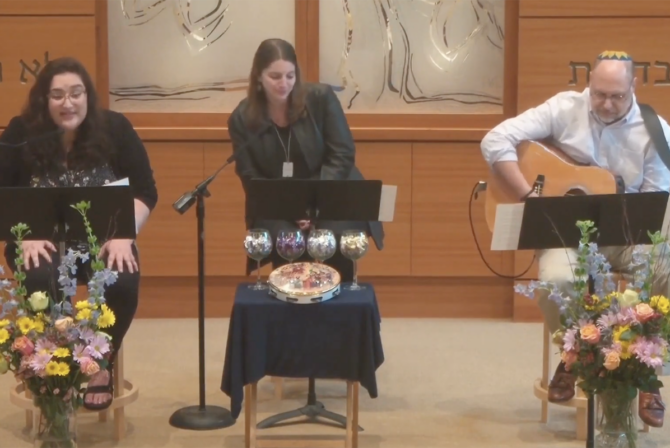During Yom Kippur, like many of you, I sat and stood for hours in synagogue, the change in posture serving as punctuation for my thoughts. As the sun crossed the sky, I thought about the person I had been for the past year, and was upset by all the ways in which I’d come up woefully short.
Over the course of Yom Kippur, the machzor guides us through feelings of awe and wonder, humility and agency, grief and hope. In contrast to God’s strength and power, we are, in the words of the Unetaneh Tokef, “a broken shard, grass that withers, a fading flower, a passing shade, a dissipating cloud, a blowing wind, flying dust, and a dream that vanishes.”
Surely, over the long haul of a day like this, we can feel small and lost. I know I did. I felt overwhelmed by the weight of my own inadequacies and regrets, and similarly overwhelmed by the work that lies ahead of me as I try to become a better person, battling my bad habits and others’ preconceptions alike. The day’s fast is designed to make us feel like we are among the dead, who do not need to eat. We feel our insignificance next to God’s greatness: we’re, again as per the Unetaneh Tokef, just sheep passing under a shepherd’s staff.
As the day ends and most of us get our hands on bagels with lox and a schmear, we find that returning to ourselves is not so easy. After an intensely spiritual day, it’s hard to come back into the “real world” of babysitters, snacks, and day to day responsibilities.
And, as usual, Judaism proves itself one smart cookie of a religion.
It is customary, upon coming home from Ne’ilah, the closing service of Yom Kippur, to put the first stake into the ground to build a sukkah. I don’t think this is meant to overwhelm us with the seemingly incessant pace of Jewish holidays in the month of Tishrei: rather, it’s meant to ground us and bring us back to earth.
From the ethereal beauty of Yom Kippur, we move straight into the holiday of Sukkot, in which we are commanded to build sukkot, temporary dwellings resembling the ones the Israelites resided in during their years journeying to Israel from slavery in Egypt. A sukkah is a purposely temporary dwelling, one in which the stars should be visible. It is comparatively delicate and flimsy.
But all buildings–and, in fact, all human creations–are impermanent. Yet we drive our stakes into the ground to assure ourselves that we are here, we are present. We do it to show that we have roots in ritual and in meaning, and that we have undertaken to build the impermanent structures of our lives with love and care.
Building sukkot means making the deliberate decision to choose life. So we brave the elements, and commit to joining our people for the long desert journey and a common destination.
We personally don’t use nails for our sukkah. Well, fine, full disclosure, I don’t technically use anything, because I am more a delegator in this process. I am a menace with a hammer, plus at this point I’m so pregnant that when I back up, there should be some noise-making mechanism going “beep…beep…beep.” But my husband and dad, and usually my boys, get together and get the sukkah kit out of the garage the day after Yom Kippur for what looks like an adult Tinker Toys set of metal rods, canvas and schach, the bamboo roof “topping” that will allow those inside a full view of the sky.
Just like building a family, building a sukkah teaches us the beauty of the ephemeral: children grow up, sukkot get taken down. When you do this year after year, the numbers of people in your sukkah grow and shrink. Your children grow taller, can do more, and then, eventually, will leave to build sukkot of their own. Time passes, rain comes through the roof. We change, and we are vulnerable.
We embrace the moments we are given as gifts. And as we admire the faces of our children and guests, we see that the sukkah is a frame for the beautiful picture we provide of the joy of our lives.
Like this post? Get the best of Kveller delivered straight to your inbox.







